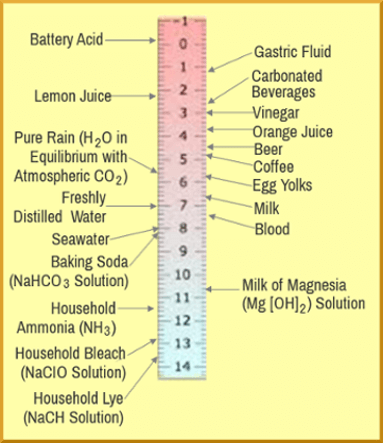What Is pH?
pH (Potential of Hydrogen) decides the level of alkalinity and acidity in your blood and plays an extremely important part in maintaining good health and also in aiding weight loss. See posts:
pH (potential of Hydrogen) – Part 1
pH (potential of Hydrogen) – Part 2
pH Food Values Of Some Common Food And Drink
It is important to maintain blood alkalinity at the optimum level of 7.2-7.5 on the pH scale of 1-14, seven being neutral. Below, you will find a list of pH food values of food and beverages with their alkaline and acidic content to help you maintain a healthy pH.
Key to pH Levels:
(a)=High Alkaline; (b)=Medium Alkaline; (c)=Low Alkaline
(d)=Low Acidic; (e)=Medium Acidic; (f)=High Acidic
Sweeteners
Alkaline
(a) Sevia
(b) Rice Syrup, Maple Syrup
(c) Unprocessed Honey (Raw), Unprocessed Sugar (Raw)
Acidic
(d) Processed Honey, Molasses
(e) Granulated White Sugar, Processed Brown Sugar
(f) Splenda, NutraSweet, Equal, Aspartame, Sweet ‘N’ Low
Fruit
Alkaline
(a) Lemons, Watermelon, Cantaloupe Melons, Honeydew Melons, Limes,
Grapefruit, Mangoes, Papayas
(b) Dates, Figs, Melons, Grapes, Papaya,Blueberries, Apples, Kiwi,
Pears, Raisins
(c) Oranges, Bananas, Cherries, Pineapple, Peaches, Avocados
Acidic
(d) Plums, Blackberries, Cranberries, Prunes
(e) Sour Cherries, Rhubarb
(f) Processed Fruit Juice
Vegetables
(Including Beans and Legumes)
Alkaline
(a) Asparagus, Onions, Vegetable Juices, Parsley (Raw), Spinach,
Broccoli, Garlic
(b) Squash, Green Beans, Beets, Celery, Lettuce, Zucchini
(c) Carrots, Tomatoes, Fresh Corn, Mushrooms, Cabbage, Peas,
Potato Skins, Olives, Soybeans, Tofu
Acidic
(d) Cooked Spinach, Kidney Beans, String Beans, Pinto Beans,
Navy Beans, Lima Beans
(e) Potatoes (Instant), Corn (Creamed)
(f) Chocolate
Nuts and Seeds
Alkaline
(a) None
(b) Almonds
(c) Chestnuts, Brazil Nuts, Pumpkin and Sunflower Seeds
Acidic
(d) Walnuts, Peanut, Pecans, Cashews
(e) None
(f) None
Oils
Alkaline
(a) Olive Oil
(b) Flax Seed Oil
(c) Canola Oil
Acidic
(d) Corn Oil
(e) None
(f) None
Grains and Cereals
Alkaline
(a) None
(b) None
(c) Amaranth, Millet, Quinoa, Wild Rice
Acidic
(d) Brown Rice, Spelt, Sprouted Wheat Bread
(e) Buckwheat, Corn, Oats, Rye, White Rice
(f) Pasta, Pastries, Wheat, White Flour
Meats
Alkaline
(a) None
(b) None
(c) None
Acidic
(d) Cold Water Fish, Venison
(e) Chicken, Lamb, Turkey
(f) Beef, Pork, Shellfish
Dairy Products
Alkaline
(a) None
(b) None (Apart from Breast Milk)
(c) Goat Cheese, Goat Milk, Soy Cheese, Soy Milk, Whey
Acidic
(d) Butter, Buttermilk, Cottage Cheese, Eggs, Yogurt
(e) Raw Milk
(f) Cheese, Homogenized Milk, Ice Cream
Beverages
Alkaline
(a) Herbal Teas, Lemon Water
(b) Green Tea
(c) Ginger Tea
Acidic
(d) Tea
(e) Coffee
(f) Beer, Soft Drinks
I hope you find pH Food Values helpful in maintaining a healthy pH. As mentioned in previous posts, poor or acidic pH can lead to weight gain.
As always, all the content on this page is for information only and advice from your doctor or other suitably qualified persons should be sought before starting any weight loss or fitness programs.
